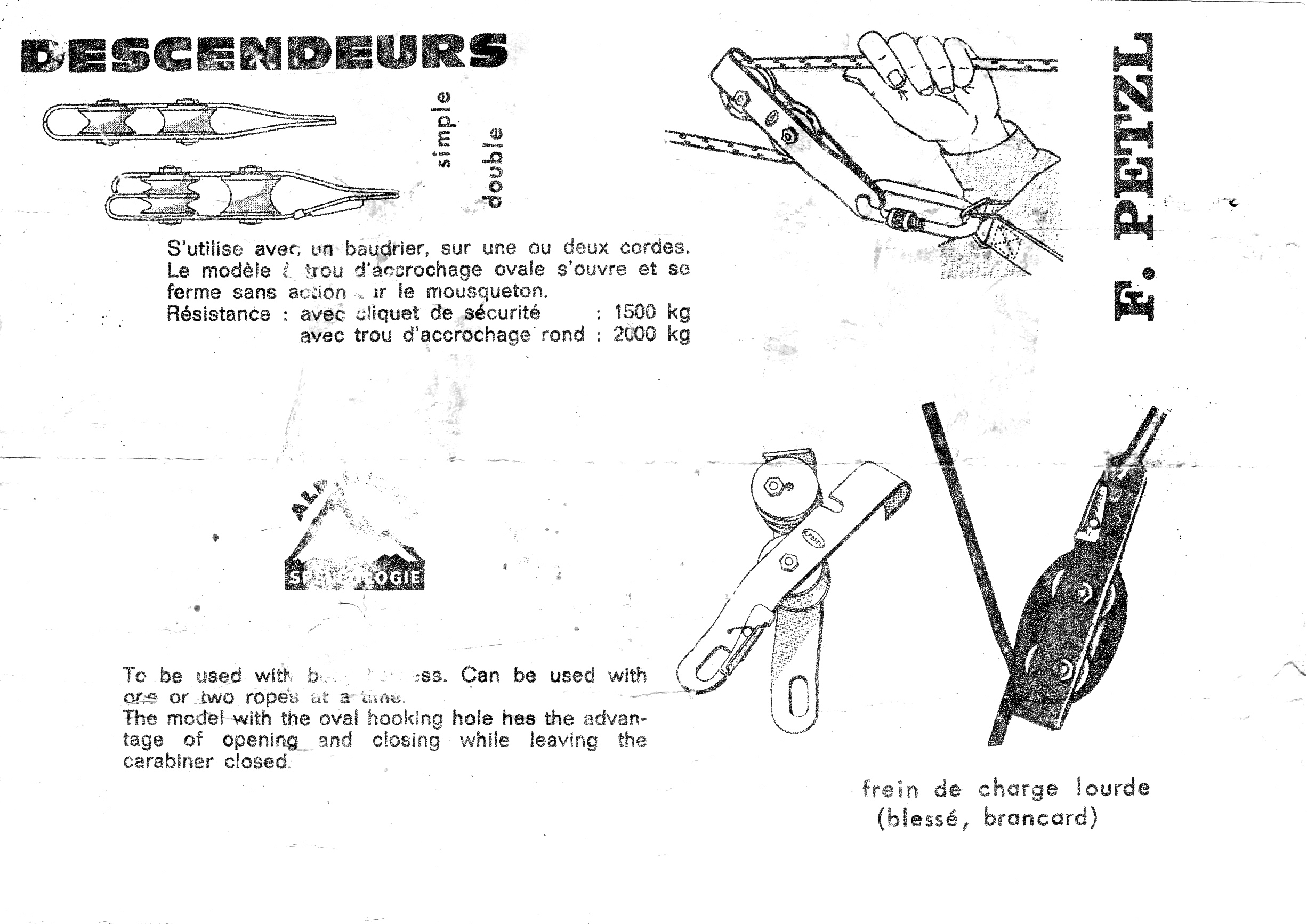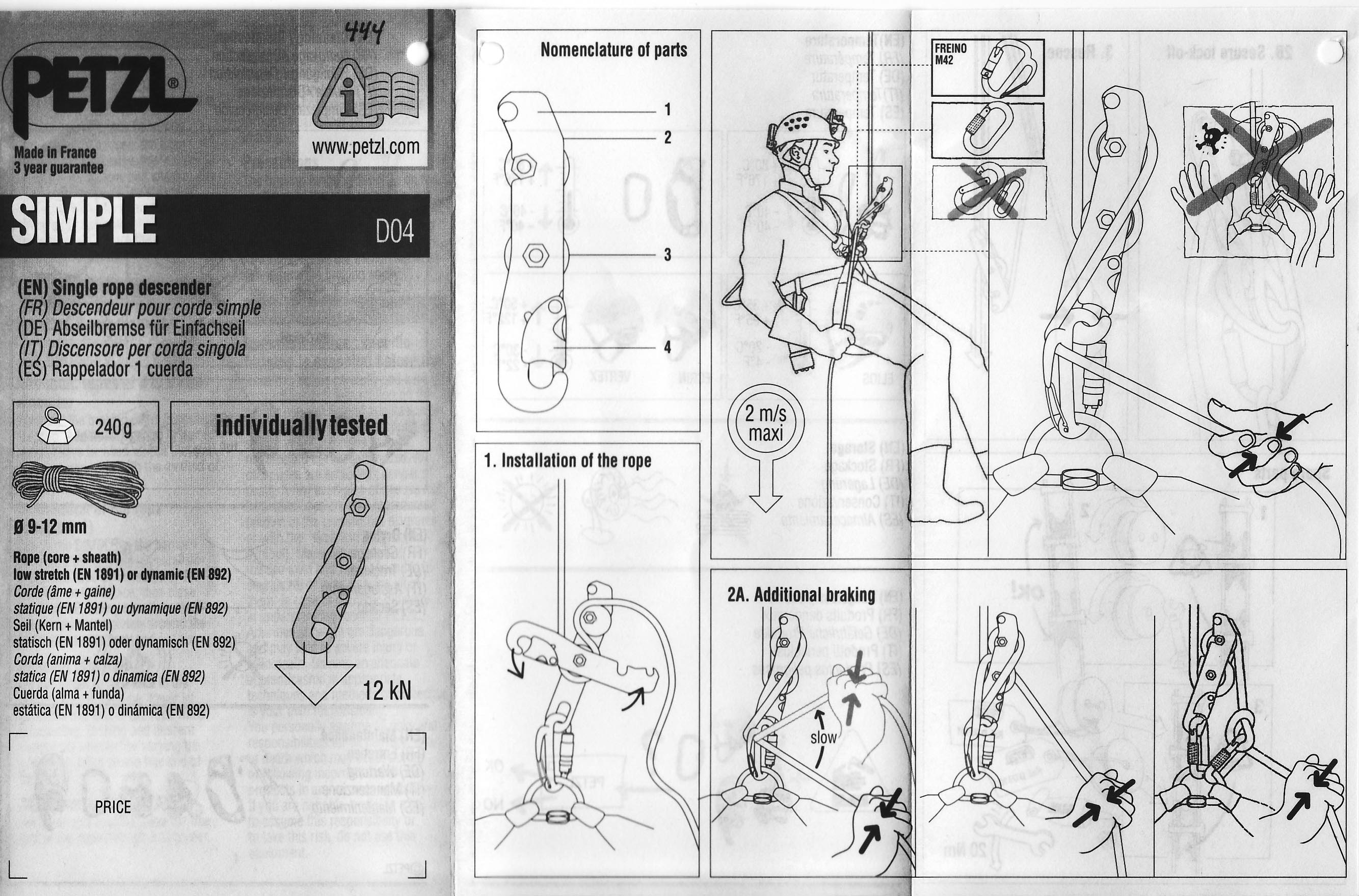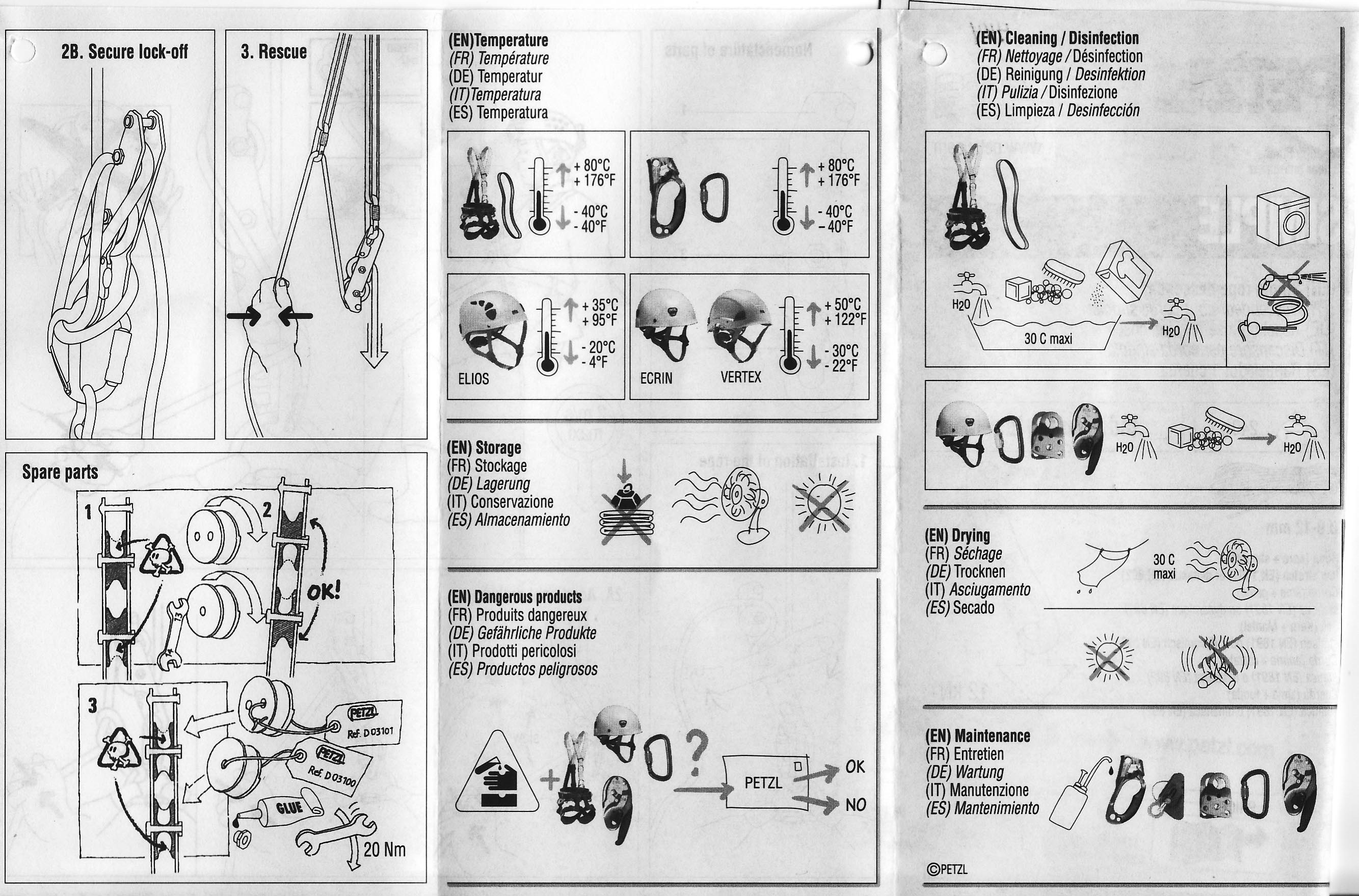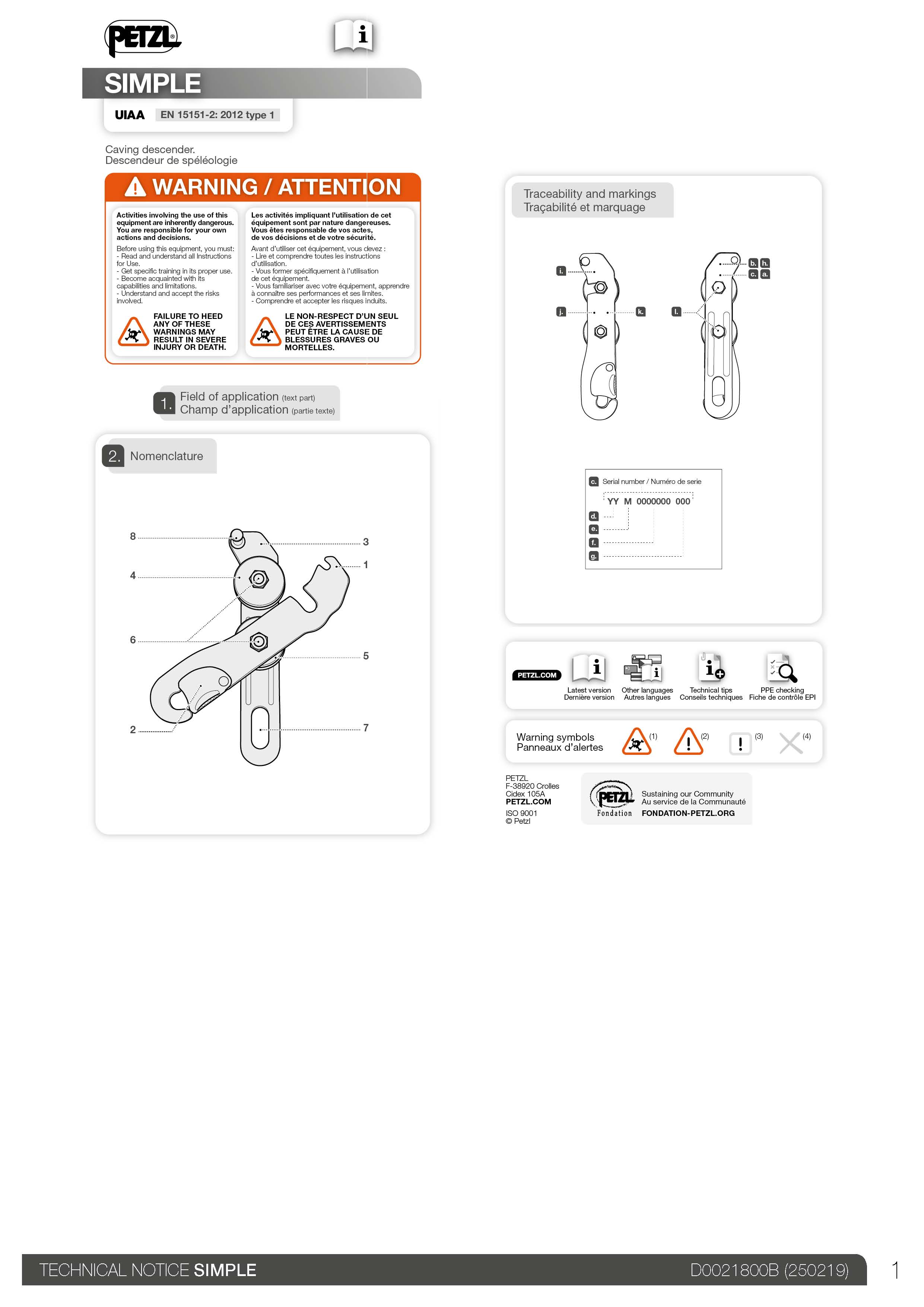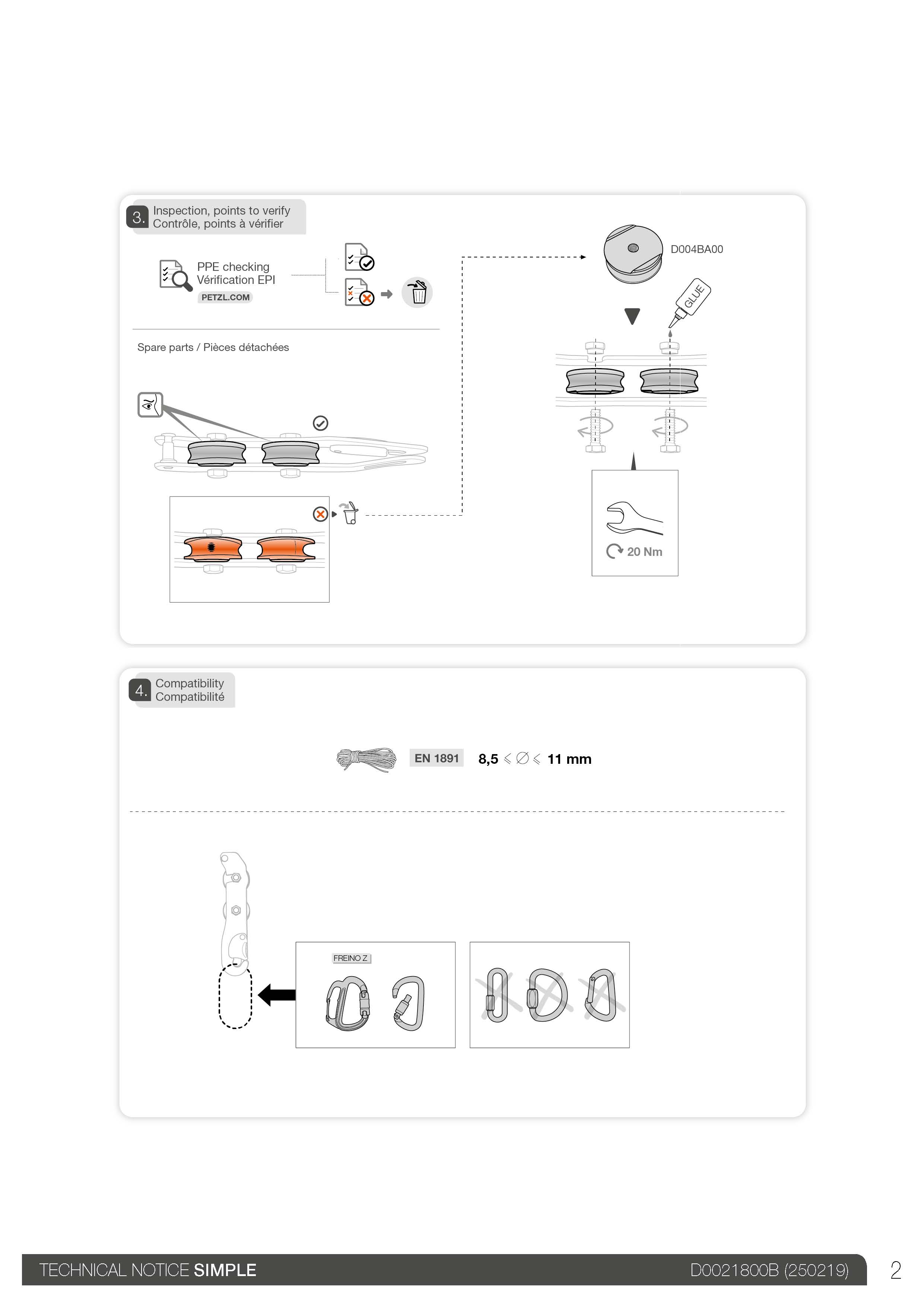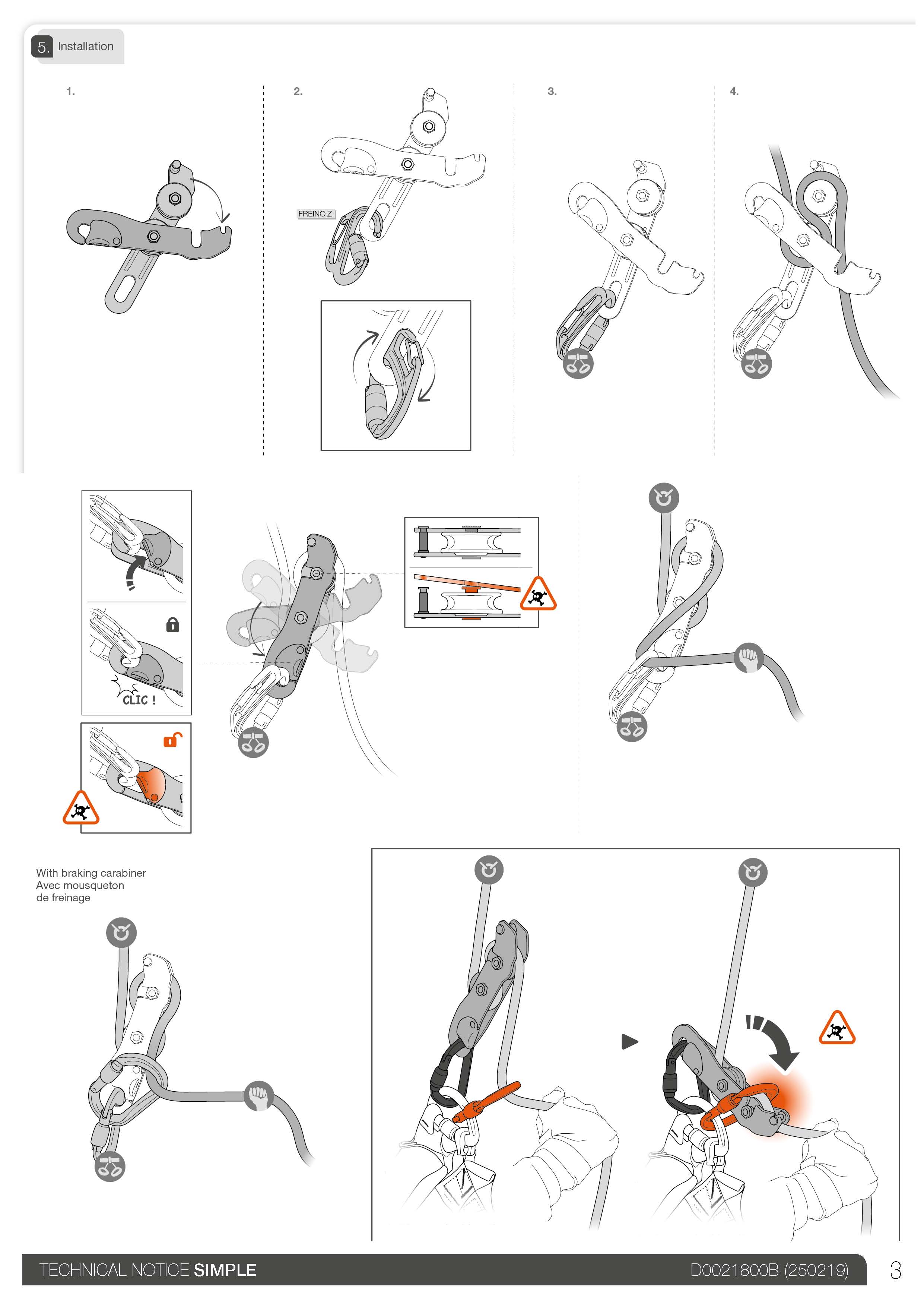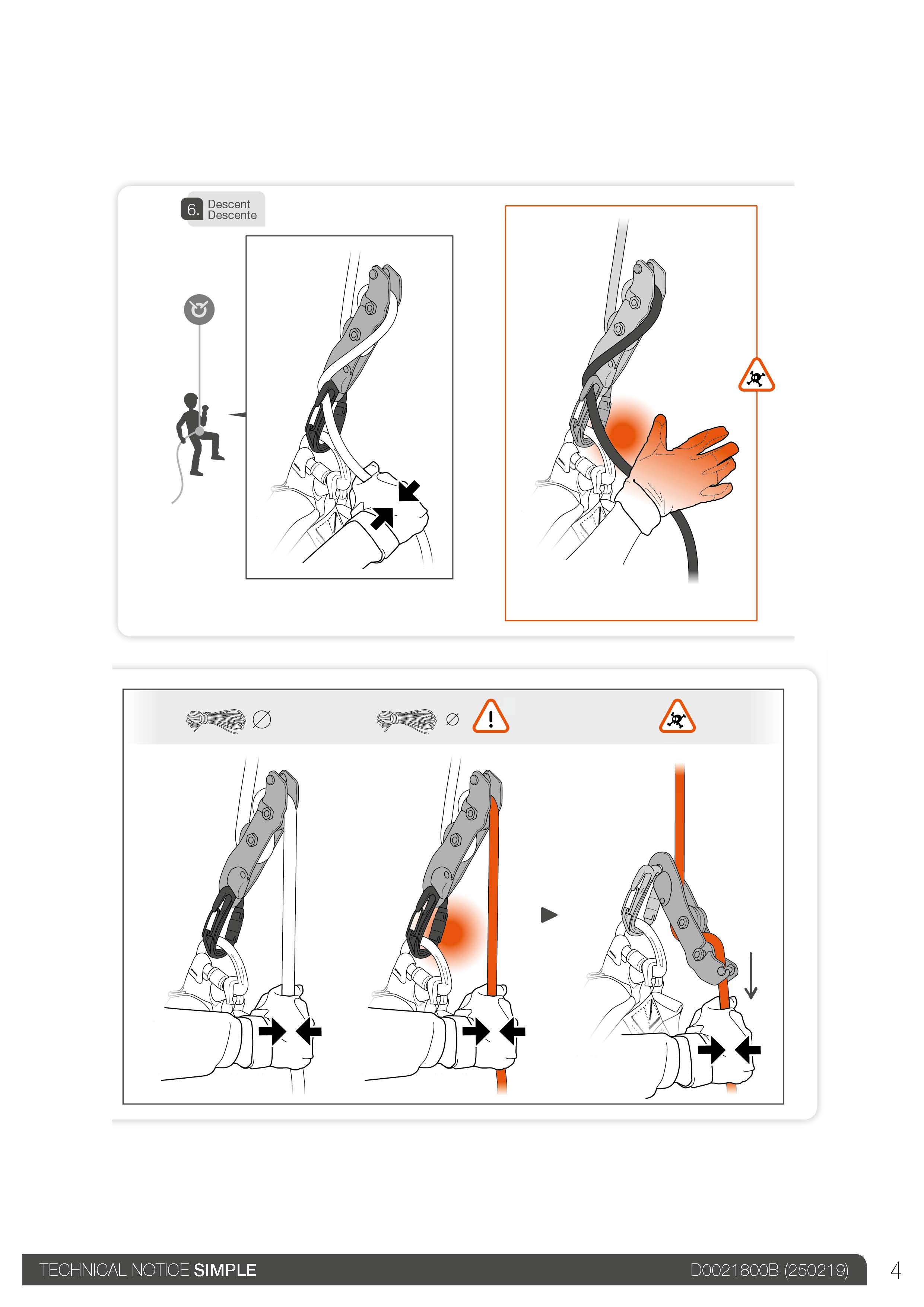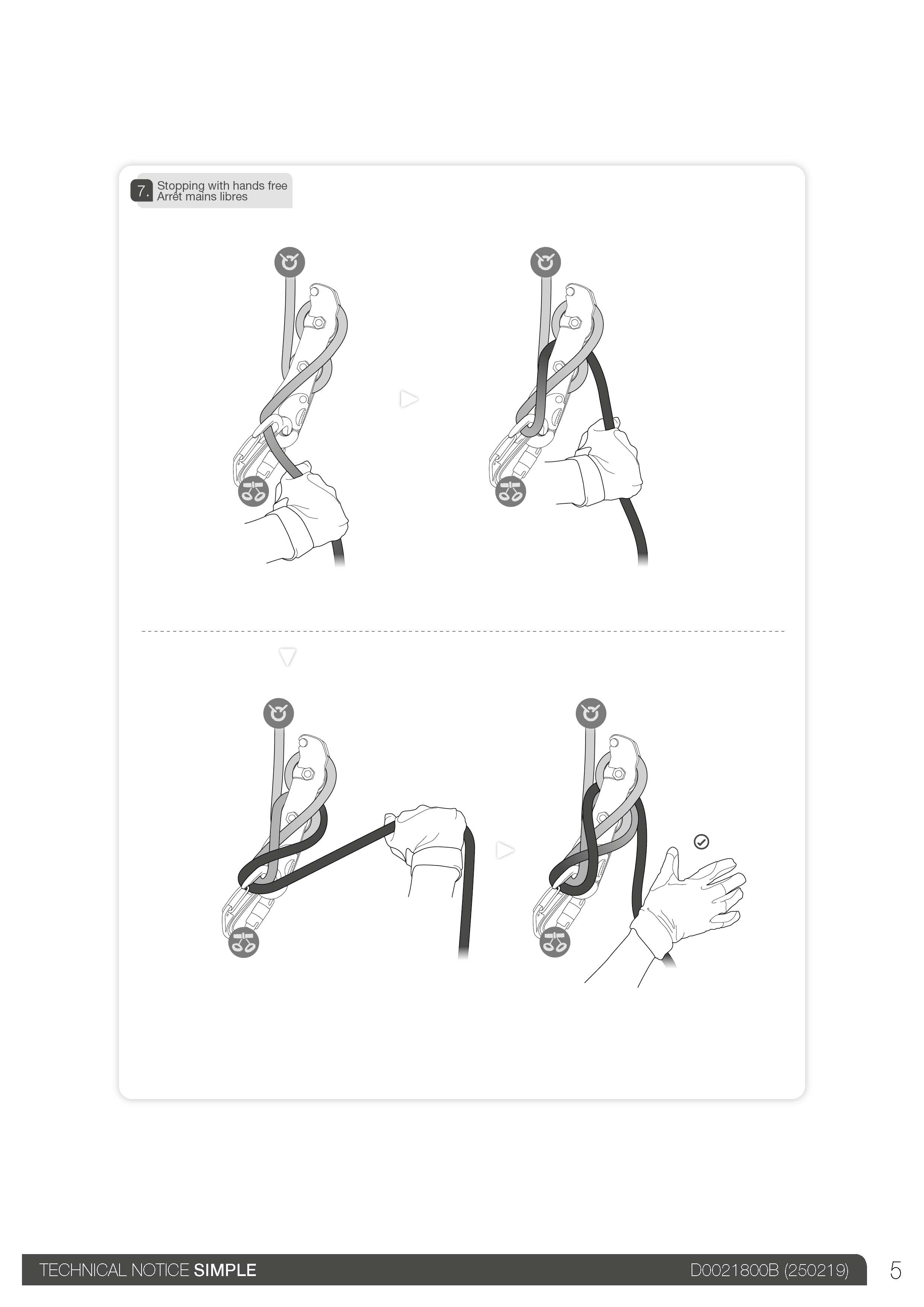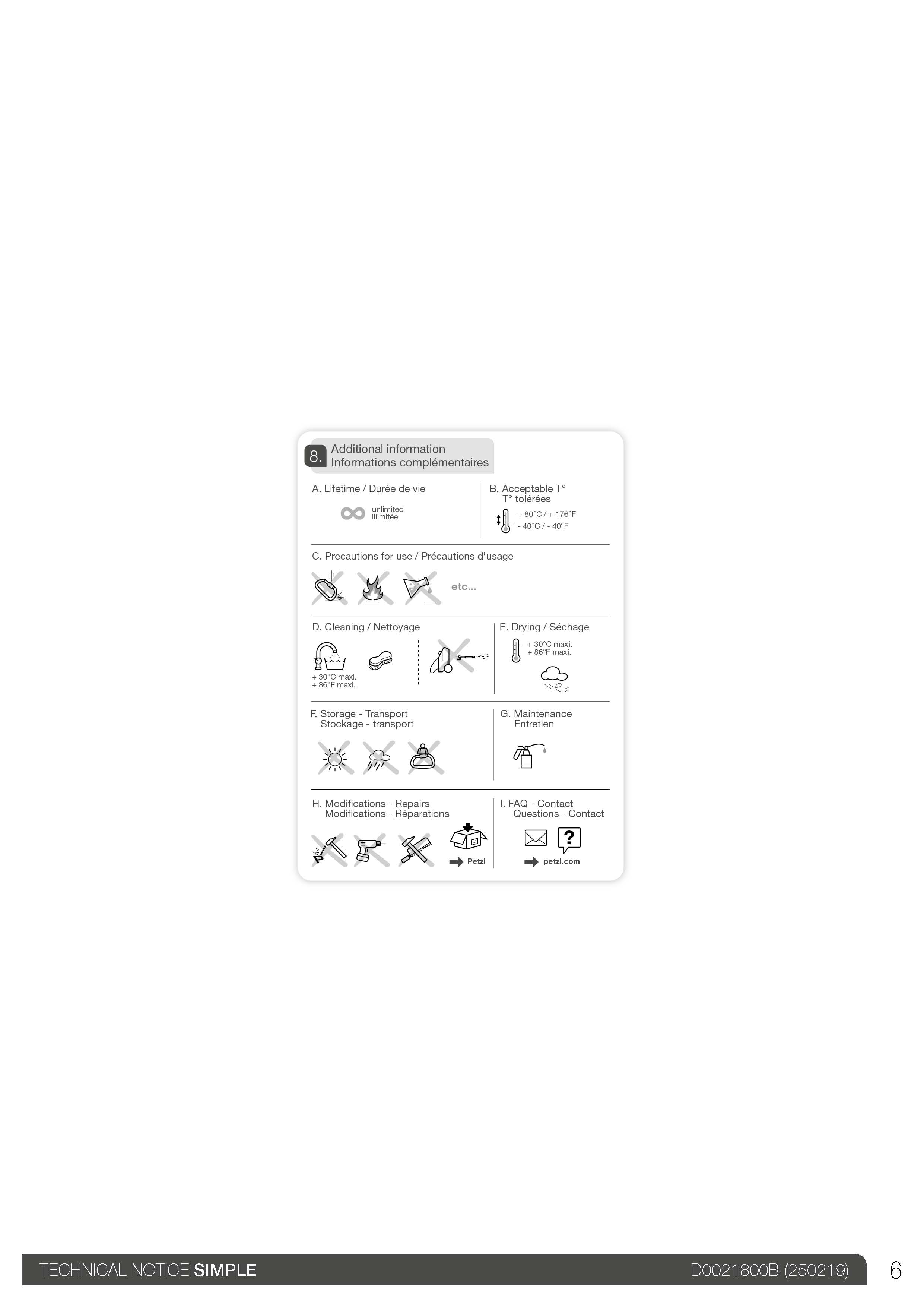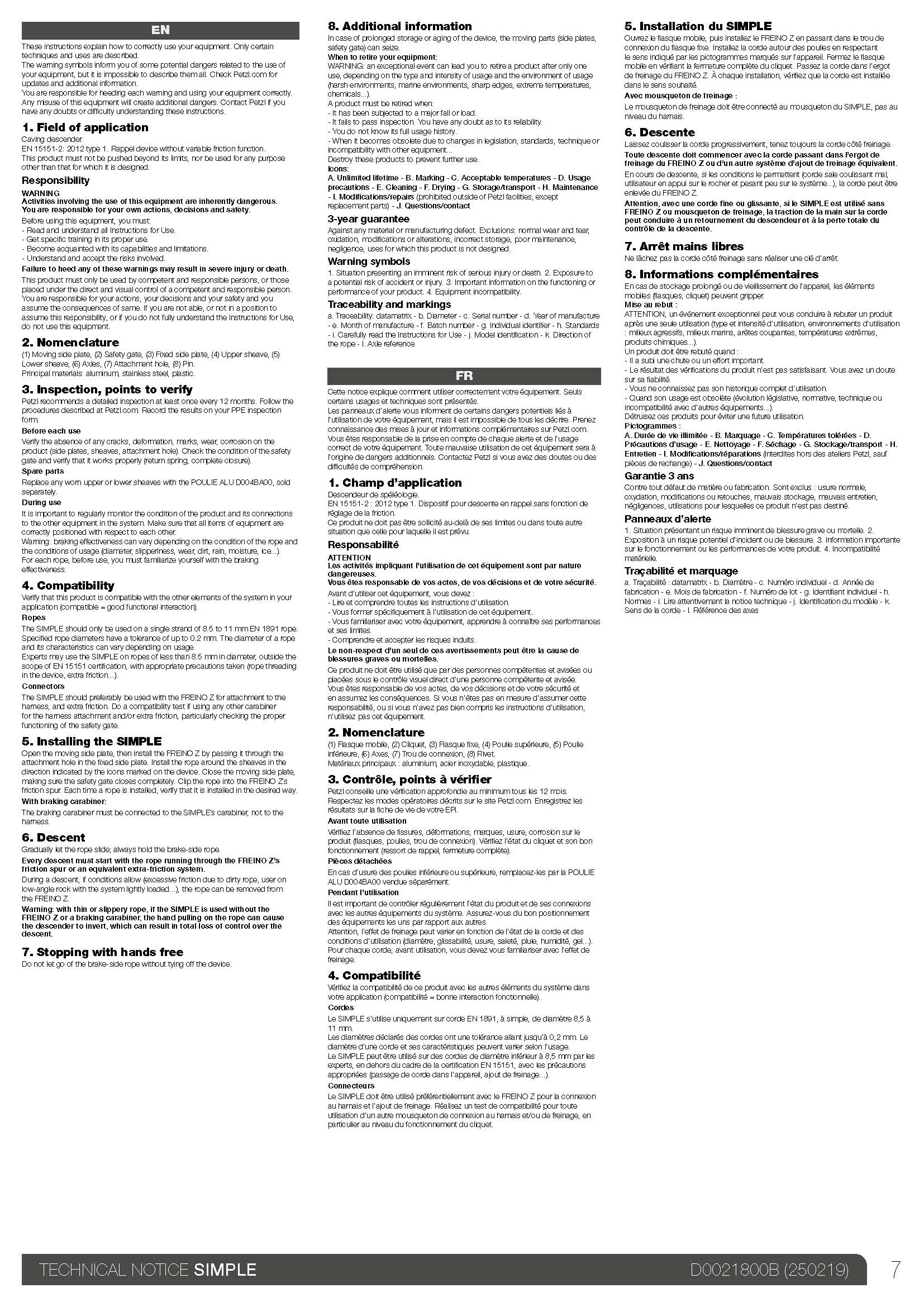Overview
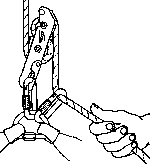 If
the bobbin is not properly closed, the bobbin can open and let
the rope escape, resulting in an air rappel. I lost a long-time
caving friend recently because of this. He was exceptionally skilled
but one small oversight proved fatal.
If
the bobbin is not properly closed, the bobbin can open and let
the rope escape, resulting in an air rappel. I lost a long-time
caving friend recently because of this. He was exceptionally skilled
but one small oversight proved fatal.
Look at the illustration and note that the seat carabiner can
press against the safety gate - this makes me nervous as well.
None of the safety gates are particularly strong. Since bobbins
are popular among the rebelay crowd, there are many opportunities
to overlook whether the side plate is closed, whether the safety
is engaged, and whether the carabiner is resting against then
gate or not.
Finally, be sure to use the safety carabiner on the trailing
line. Many people fail to do so.
|
 |
Warning:
Be certain that the bobbin is closed and the safety catch
is engaged before trusting your weight to the device.
I lost a skilled friend who overlooked this - A MISTAKE HE MADE ONLY ONCE. |
 |
|
[ Top
| Version B
| Version C
| Version D
| Version E
| Version F
| Version G
| Version H
| Version I
| Version J
| Version K
| Return to Bobbins
]
Version A
(#1206)
Technical Details
I acquired my Petzl Simple Version A used on eBay from Albéric Sibille in 2009. It is the oldest bobbin on this page.
Version A is 193 mm. tall, 44 mm. wide, 31 mm. thick, and weighs 214 g. The side plates and bollards are much like those on Version D, except the upper bollard appears to have had a U-shaped groove, much like the lower one (it is heavily worn so it is hard to tell). Like Version E, Version A has a quick-attachment
feature. The attachment point on the fixed side plate is a 24 mm. high by 14 mm. wide (worn) hole located 3 mm.
off center. A similar hole on the pivoting side plate has been
cut open on the narrow side, so the side plate resembles a hook.
The opening of the hook is covered by a spring loaded, stamped
steel, sheet metal gate riveted to the side plate.
The pivoting side plate is stamped with has "F. PETZL" inside an oval, "FRANCE," and "2652." The bolt heads have "U V" and "A 2" in raised letters.
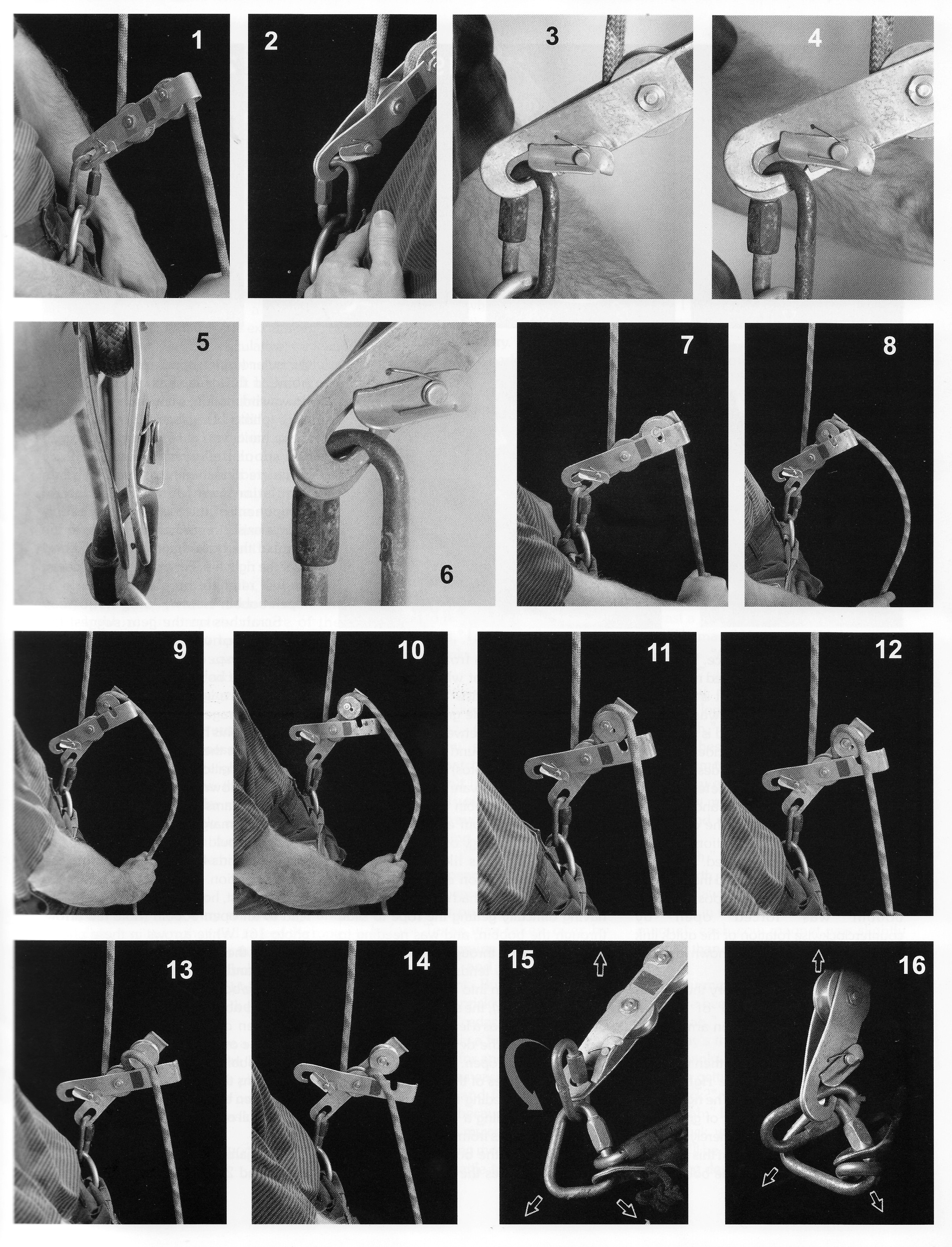
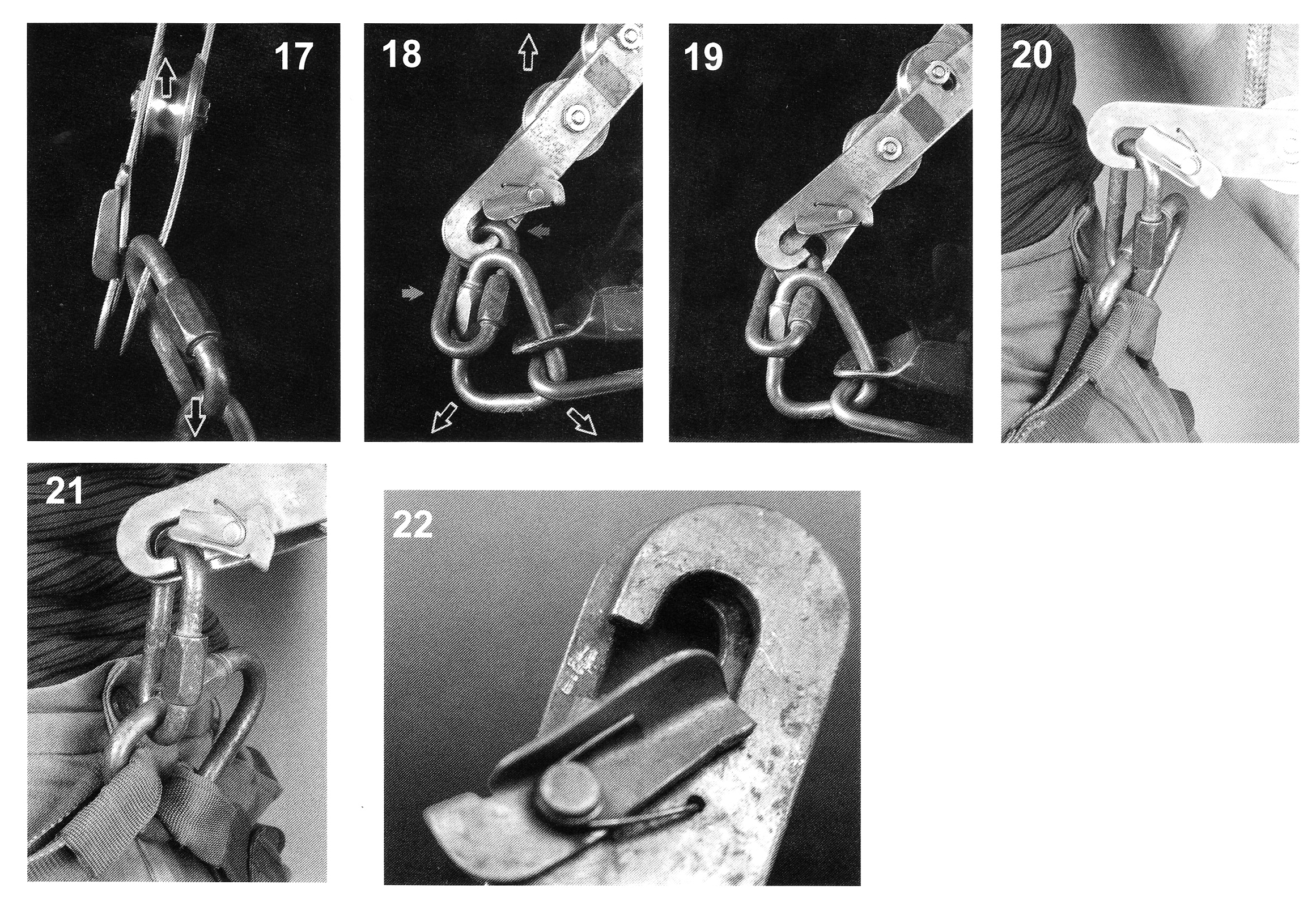 The gate is crudely made and the spring is quite weak, although this might be related to its age. The large tab makes the gate rather easy to operate, but also makes it easy to open by accident. Some people believe that this contributed to my friend’s death (one possibility is seen in the images linked at left, taken from the June 2005 NSS News, photos by Laura Maish). I don't know for sure (I wasn't there to witness the tragedy), but I prefer a more secure gate.
The gate is crudely made and the spring is quite weak, although this might be related to its age. The large tab makes the gate rather easy to operate, but also makes it easy to open by accident. Some people believe that this contributed to my friend’s death (one possibility is seen in the images linked at left, taken from the June 2005 NSS News, photos by Laura Maish). I don't know for sure (I wasn't there to witness the tragedy), but I prefer a more secure gate.
I suspect that the "2652" was a previous owner’s identifying mark.
The May 2007 Petzl corporate brochure states that Petzl brought their first bobbin to market in 1968 under the name "Produits Fernand Petzl" (Fernand Petzl Products). That brochure does not show the first bobbin, but perhaps this is one of them.
[ Top
| Version A
| Version C
| Version D
| Version E
| Version F
| Version G
| Version H
| Version I
| Version J
| Version K
| Return to Bobbins
]
Version B
(#1220)
Technical Details
I acquired my Petzl Simple Version B used on eBay from Mariana Oliveira in 2009.
Version A is 193 mm. tall, 45 mm. wide, 26 mm. thick, and weighs 214 g. The main difference between Version B and Version A is that the top bollard on Version B has a v-shaped groove instead of the u-shaped groove found on Version A.
The pivoting side plate is stamped with has "F. PETZL" inside an oval and "FRANCE." The top bollard bolt heads have "U V" and "A 2" in raised letters, while the bottom bollard bolt head has "UA2" in raised letters.
The gate spring is weak, and the gate does not operate smoothly.
The v-shaped groove in the top bollard gives more friction than the older u-shaped groove, especially on thinner ropes.
[ Top
| Version A
| Version B
| Version D
| Version E
| Version F
| Version G
| Version H
| Version I
| Version J
| Version K
| Return to Bobbins
]
Version C
(#2317)
Technical Details
I acquired two of these in 2017 as part of Bob Thrun’s collection.
This version is 192 mm. tall, 45 mm. wide, 31 mm. thick, and weighs 233 g.
The pivoting side plate is stamped with "F.PETZL" inside an ellipse and "FRANCE." The bolt heads
are marked "UV" and "A2."
The only difference between this Version C and Version D is the markings and their location.
[ Top
| Version A
| Version B
| Version C
| Version E
| Version F
| Version G
| Version H
| Version I
| Version J
| Version K
| Return to Bobbins
]
Version D
(#441)
Technical Details
I acquired this descender from Speleoshoppe in 1979.
Version D is 187 mm. tall, 45 mm. wide, 31 mm. thick, and weighs 220 g.
The two side plates are made of 32 by 3.3 mm. aluminum.
The upper end of each side plate is bent inwards in a quarter
circle so that when the bobbin is in use the side plates keep
the rope on the top bollard. The lower ends of the side plates
are bent to converge at the attachment point, which consists of
a 14 mm. beveled hole in each side plate. One side plate
pivots to allow threading the rope. The bollards are turned aluminum
with a milled slot to keep them from rotating on the fixed side
plate. The bollards are drilled and tapped then bolted to the
fixed side plate with 7 mm. A2 bolts. Shoulder nuts lock
the bollards in place and also retain the pivoting side plate.
The pivoting side plate pivots on the lower shoulder nut and has
a slot to allow clearing the upper nut. The lower U-groove bollard
is mounted through a hole in its center, but the upper V-groove
bollard uses an off-centered arrangement to allow a smaller clearance
slot in the upper side plate.
The pivoting side plate is stamped with an icon illustrating
how the descender is threaded, but anyone who needs this assistance
shouldn't be using a bobbin anyhow. It is also stamped "PETZL,"
"MAXI 1500 KG," and "FRANCE." The bolt heads
are marked "THIEL" and "A2."
The attachment point on the pivoting side plate is beveled
on the inside, rather than the outside. This is an obvious oversight
in manufacturing, since the beveling serves no purpose there.
Otherwise, the bobbin is fairly well made. The threaded bollards
provide a much stronger mounting than if they had been just bolted
on through a cylindrical hole with bolt and nut. Since only about
one half of each bollard is exposed to the rope, the bollards
wear unevenly. Most bobbins are designed to allow reversing the
bollards, effectively doubling the life of the descender. The
lower bollard is symmetrical and requires no modification to allow
reversing. The upper bollard could have been left asymmetrical,
but Petzl provided a second threaded mounting hole to allow reversing
the upper bollard.
This is the simplest bobbin in my collection, and although
I don't use it as often as others, it probably is the best
for those who prefer simplicity and do not need to cross rebelays. There is really nothing extra
on this bobbin, and also very little to fail. Even if the user
were foolish enough to rig in backwards, the closed attachment
hole on the pivoting side plate would almost certainly prevent
the bobbin from opening. After doing the research for this article,
I'm tempted to make this my primary bobbin in the future (except
for rebelay pitches) - assuming I ever use a bobbin again.
[ Top
| Version A
| Version B
| Version C
| Version D
| Version F
| Version G
| Version H
| Version I
| Version J
| Version K
| Return to Bobbins
]
Version E
(#442, 1185)
Technical Details
I acquired this descender from Speleoshoppe in 1979 at the
same time as Version D. I acquired a second one new (old stock) from Hawill’s Ltd. in 2008.
It differs from Version D by having a quick-attachment
feature. The attachment point on the fixed side plate is enlarged
to a 23 mm. high by 13 mm. wide hole located 3 mm.
off center. A similar hole on the pivoting side plate has been
cut open on the narrow side, so the side plate resembles a hook.
The opening of the hook is covered by a spring loaded, stamped
steel, sheet metal guard which is attached to the side plate with a semi-tubular rivet.
The markings are identical to Version D’s.
The quick attach feature allows the user to keep the descender
attached to the seat maillon while rigging into or derigging from
the main line. This is a nice feature, but usually I find that
the limited clearances provided may the task more hassle than
it is worth. In addition, the guard tends to get fouled with mud,
thus defeating the closing action of the safety spring. Corrosion
is also a problem, which is why mine won't function. The roll
rivet is installed incorrectly, with the relatively smooth rivet
head on the outside and the sharp, poorly formed roll crimp on
the inside next to the rope path. Furthermore, the attachment
point is not beveled. In general, I find the idea of a quick attach
feature very desirable, but the execution of the idea could be
substantially improved on both this descender and many others.
[ Top
| Version A
| Version B
| Version C
| Version D
| Version E
| Version G
| Version H
| Version I
| Version J
| Version K
| Return to Bobbins
]
Version F
(#1242)
Technical Details
I acquired my this bobbin from Francois in 2009. He bought it directly from Petzl in 1982.
Version F is 189 mm. tall, 45 mm. wide, 31 mm. thick, and weighs 236 g.
The pivoting side plate is stamped with an icon illustrating
how the descender is threaded, but anyone who needs this assistance
shouldn't be using a bobbin anyhow. It is also stamped with the Petzl logo,"MAXI 1500 KG," and "FRANCE." The bolt heads
are marked with an "L" inside a diamond and "A2."
Version F is essentially an anodized Version E.
[ Top
| Version A
| Version B
| Version C
| Version D
| Version E
| Version F
| Version H
| Version I
| Version J
| Version K
| Return to Bobbins
]
Version G
(#444)
Technical Details
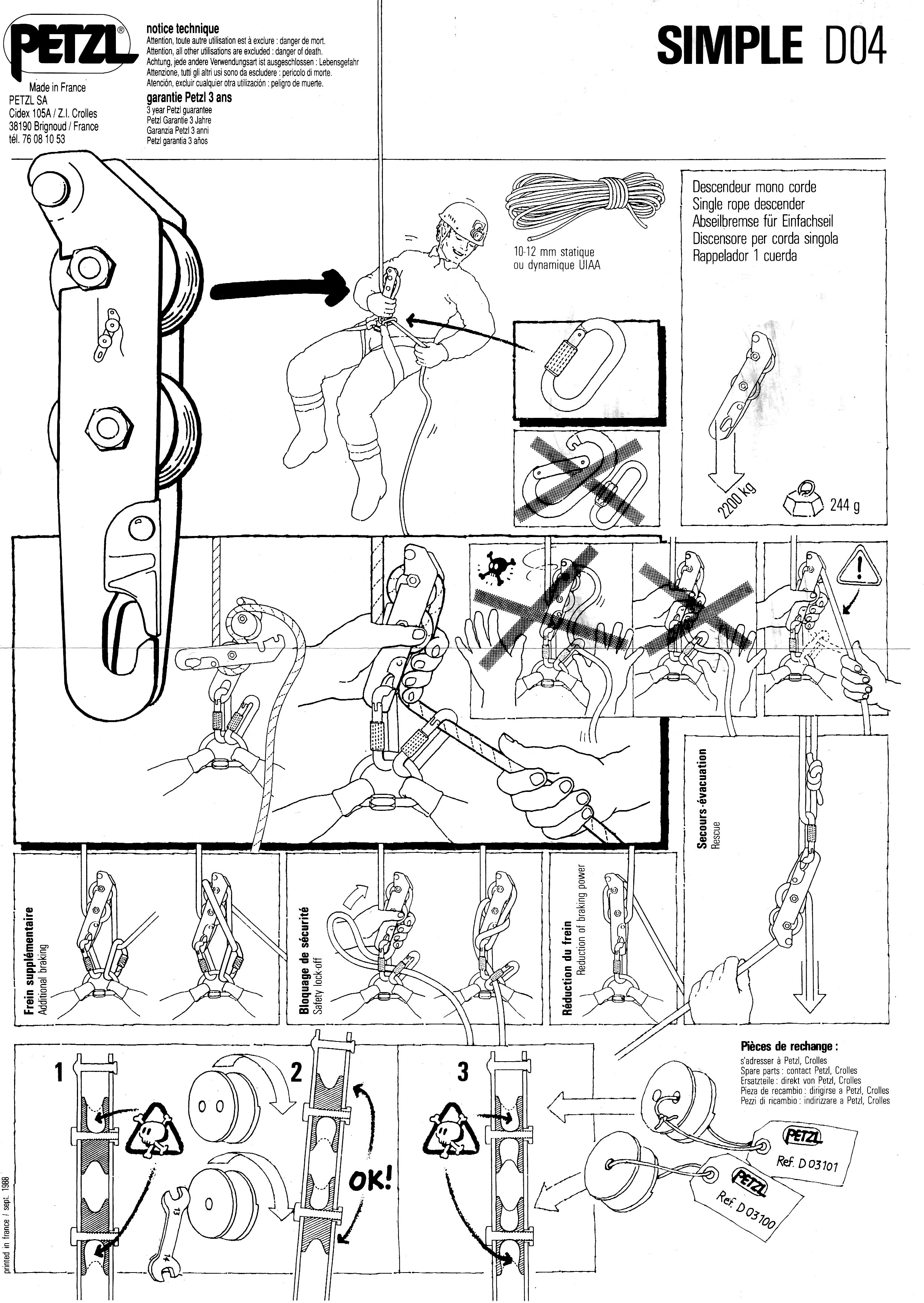 I obtained this descender from J. E. Weinel Inc. around 1987.
I obtained this descender from J. E. Weinel Inc. around 1987.
The major difference between this and the preceding design
is the inclusion of a third auxiliary rod and modification of
the side plates to accommodate the third rod. A reduced diameter
end of the steel rod passes through the upper end of the fixed
side plate. A steel washer is then placed over the outside end
of the rod and the end formed into a round rivet head. The opposite
end of the rod has a flange to engage the pivoting side plate.
The side plates are cut out of 3 mm. aluminum and red anodized.
The upper end of the side plates are offset to place the auxiliary
bollard closer to the "up" side of the main rope. The
pivoting side plate is notched to clear the auxiliary bollard
as well as the upper main bollard nut. The pivoting side plate
has a quick attack feature similar to Version E’s. None of
the attachment points are beveled.
The pivoting side plate is stamped with an illustration of
how to rig the bobbin, the Petzl logo, and "FRANCE."
The bollard bolt heads are marked with"A2."
The auxiliary bollard works very well for keeping the rope
on the upper main bollard without binding, but is less satisfactory
when used as part of the braking system. The rod is too small
to function well as a third braking surface, has no means to ensure
that the rope stays on the rod reliably, and is located where
it forces the rope into an inconvenient position. This last point
is particularly noticeable if the trailing rope passes through
a maillon clipped to the seat maillon as indicated in the Petzl
instructions and required for safety. In this case it requires
too many contortions to switch from the two bollard mode to the
three bollard mode.
[ Top
| Version A
| Version B
| Version C
| Version D
| Version E
| Version F
| Version G
| Version I
| Version J
| Version K
| Return to Bobbins
]
Version H
(#443, 2419)
Technical Details
I acquired this descender in 1990, but do not have a record of from whom. I acquired another in 2017 as part of Bob Thrun’s collection.
This bobbin is almost identical to previous version, except for
two changes. The first and significant change is that the fixed
side plate is stamped to provide two reinforcing ribs on the lower
portion. The second, of no real importance, is that the rivet
holding the gate is installed with the head on the inner side
of the side plate.
The pivoting side plate is stamped with an illustration of
how to rig the bobbin, the Petzl logo, and "FRANCE."
The bollard bolt heads are marked with "IN-IV" and "A2-70."
The reinforcing should add some rigidity. I would have extended
it further, not because doing so was necessary, but because it
could be advantageous and could be done for essentially no cost.
[ Top
| Version A
| Version B
| Version C
| Version D
| Version E
| Version F
| Version G
| Version H
| Version I
| Version J
| Version K
| Return to Bobbins
]
Version I
(#2496)
Technical Details
I acquired this descender as new old stock from On Rope 1 at the 2018 NSS Convention.
This Petzl Simple is 196 mm.
tall, 45 mm.
wide, 32 mm.
thick, and weighs 242 g.
This bobbin is almost identical to the previous version, the main difference being the lack of a washer at the riveted end of the auxiliary bollard.
The markings are also different. The pivoting side plate is stamped with an illustration of
how to rig the bobbin, the Petzl logo, and "FRANCE."
The fixed plate is stamped with a rigging illustration. The bollard bolt heads are marked with "PETZL" and "A2-80."
The lack of a washer does not seem to have a significant adverse effect.
[ Top
| Version A
| Version B
| Version C
| Version D
| Version E
| Version F
| Version G
| Version H
| Version I
| Version K
| Return to Bobbins
]
Version J
(#1010)
Technical Details
I acquired this descender from Inner Mountain Outfitters in
2006.
Version I differs from Version H in the clip-in area
of the front plate. The lower portion of the plate widens to 42 mm.
overall and 17.6 mm. at the spine of the attachment hook.
The gate is now plastic. It pivots on a steel rivet, and a spring
set in a deep slot closes the gate. With the gate closed, the
opening is only 15.8 mm. high. The gate has a widened flat
spot on the outside that is clearly designed to provide a convenient
place for one’s thumb to act to open the gate.
The pivoting side plate is stamped with an illustration of
how to rig the bobbin, the Petzl logo, and "FRANCE."
The fixed plate is also stamped with an illustration of how to
rig the bobbin. This diagram is reversed from the one on the pivoting
side plate since one is looking from the other side. The fixed
plate is also printed with "06031FE9591." The bollard
bolt heads are marked with "PETZL" and "A2-80."
The Petzl logo is molded into the gate.
Petzl switched to a plastic gate on their on their stop
bobbin by 1997, but I didn't see one on a standard bobbin
until 2006. I can't think of any reason for the delay other than
the time needed to sell the existing inventory of the earlier
design. This gate design greatly reduces the risk of having the
seat carabiner force the gate open. It also eliminates the corrosion
problem that I've had with the metal gates on some of my other
Petzl bobbins. Curiously, the hook does not have the reinforcing
found on their stop bobbin, version
E.
[ Top
| Version A
| Version B
| Version C
| Version D
| Version E
| Version F
| Version G
| Version H
| Version I
| Version J
| Return to Bobbins
]
Version K
(#2527)
Technical Details
I acquired this descender from Petzl America in 2019.
This version is 197 mm.
tall, 47 mm.
wide, 32 mm.
thick, and weighs 251 g.
The eye in the fixed side plate is longer than in previous versions. This allows this version to work with the revised Petzl Freino.
The pivoting side plate is stamped with a book-with-an-"i" icon, "SIMPLE," an illustration of
how to rig the bobbin, and the Petzl logo.
The fixed plate is printed with "EN15151-2:2012," "Ø8,5-11 mm," "UIAA," "19E0192202525," and a scanner code. The bollard
bolt heads are marked with "PETZL" and "A2-80."
The Petzl logo is molded into the gate.
The longer eye in the fixed side plate allows this version to work with the revised Petzl Freino. The newer Freino must be "flipped" through the eye to function properly, and previous versions did not allow enough clearance to do this.
[ Top
| Version A
| Version B
| Version C
| Version D
| Version E
| Version F
| Version G
| Version H
| Version I
| Version J
| Version K
]



 If
the bobbin is not properly closed, the bobbin can open and let
the rope escape, resulting in an air rappel. I lost a long-time
caving friend recently because of this. He was exceptionally skilled
but one small oversight proved fatal.
If
the bobbin is not properly closed, the bobbin can open and let
the rope escape, resulting in an air rappel. I lost a long-time
caving friend recently because of this. He was exceptionally skilled
but one small oversight proved fatal.

